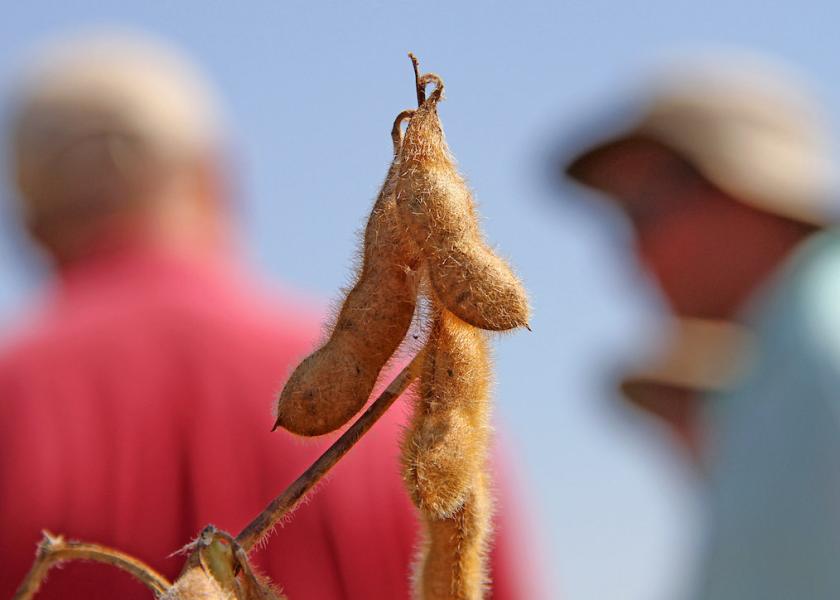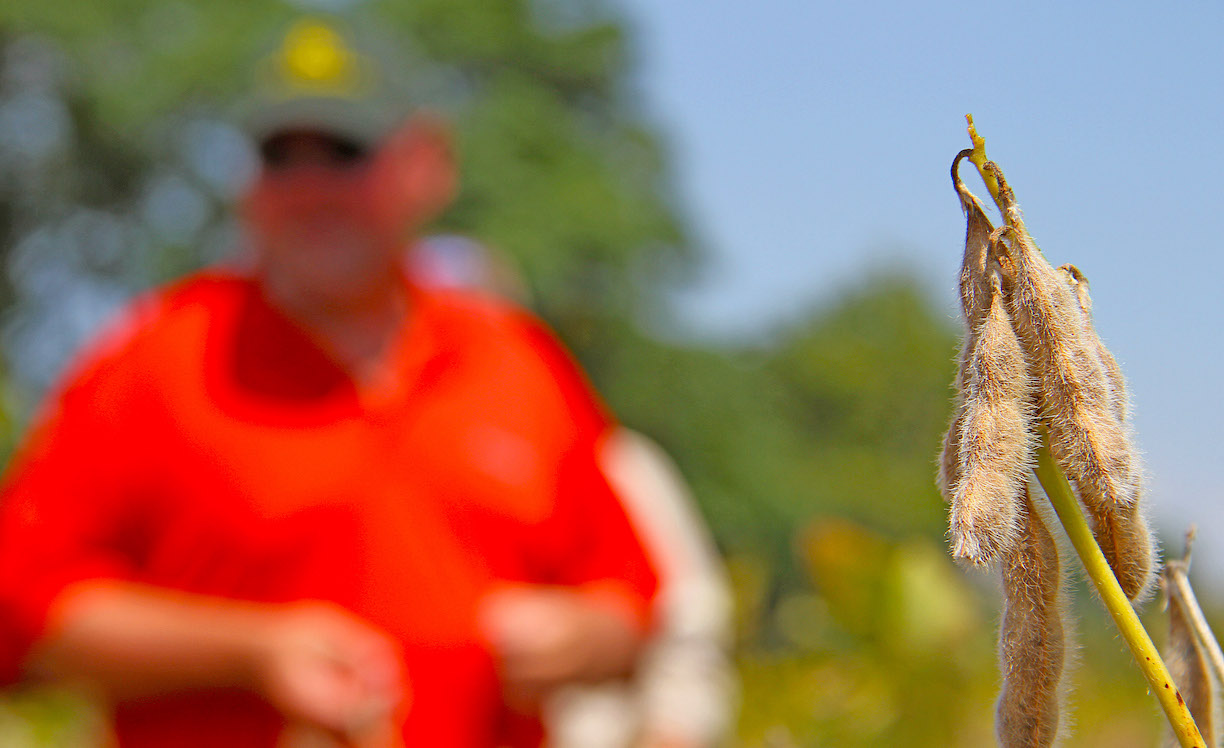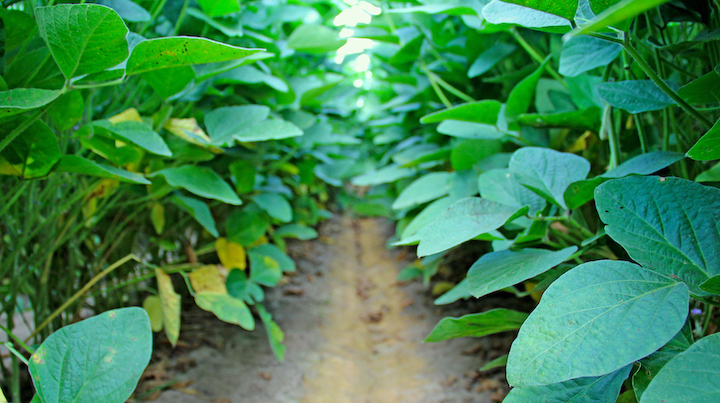Triple-Crop Soybean Success as Illinois Farmer Bucks Consensus

Triple crop soybeans in Illinois? Timing is the key that turns the lock for a heretic farmer on a soybean, pea, and rye threesome.
Nonconformity is nature in Bill Jones’ world. In 2020, he triple-cropped to the tune of $1,700 per acre profit on 125 acres. “I don’t care at all that some people think I need to be in the nuthouse,” Jones says. “This is about ROI, hitting yield averages, and taking care of my soil. Home runs are fine, but they’re for somebody else to chase.”
The Reckoning
On flat, happy black soil, as well as timber soil atop rolling hills, Jones*, 61, grows corn, food-grade corn for tortilla chips, peas, rye, and soybeans—all dryland—on a base of conventional ground, along with 1,400 organic acres in east-central Illinois’ Champaign and Vermilion counties.
A fifth-generation grower, Jones hails from a line of outliers. His great-grandfather steered a side-business via a steam engine to custom plow virgin land. Jones is cut from the same cloth, engineering a steady rotation of unique field trials and ventures, with a litany of innovations notched on his belt.
Ask Jones a crop-related question and expect him to tear into the agronomic bull’s-eye, leaving no meat on the bone. Plain talk.
“Some farmers don’t try anything new because they’re afraid to fail; afraid of the bulls*** they know others will throw at them,” Jones insists. “If you’re afraid of criticism, then your farm will never be near what it could be.”
“There is nothing we haven’t tried,” he continues. “We pelletized corn stover and had it burning 200 degrees hotter than wood chips. We even had it approved by the EPA, and our ash could go right back on the field because it was just natural minerals. But like so many things, it sometimes comes down to time and money. Figuring out something new can be the easy part of innovation, but getting somebody behind it can be the hard part.”
“I’ve tried so many double-crop variations that I can’t count them, but rye-soybeans is really serious,” Jones adds. “I recently made 70-bushel beans on a rye double crop, and that means about 10 months of carbon absorption by crops on that ground and keeping my dirt in place.”
Jones’s double-crop success drove him to uncharted waters and toward a crop trifecta: “I had never heard of anyone in my geography triple-cropping, but why not find out for myself instead of relying on the crowd’s opinion?”

In the fall of 2019, he planted 125 organic acres of rye, primarily as weed control. Roughly six months later, in March 2020, he planted 88-day peas into the rye, giving the legume a means to climb. “We got too much rain and I couldn’t get in there to mow. The peas went up the rye and looked beautiful, so we left them alone.”
By mid-June, both crops were ready for cutting. Jones combined them together and had the loads cleaned and separated. Fields empty, Jones hit a moment of reckoning—the soybean window was still open.
He planted soybeans across the 125 acres and harvested in fall. The three-crop ROI was an absolute stunner, according to Jones: $1,700 per acre. “That was even before commodity prices exploded. That was back during $7 beans and $8 peas. Guys have to realize: When there is such a high level of diversity in a field, there is so much more going on than just yield numbers.”
Roots in the Ground
In 2021, Jones triple-cropped again, once more finding success in the formula. “When we’ve got something in the soil all year, we’re feeding the soil, not just taking things out. When we get the timing right on rye and a legume, that increases the protein level and the value of the crop. We were first in one variety and second in another pea variety for protein value for Benson Hill last year. That adds at least five points to the protein value.”
“There are so many areas affecting the bottom line. Just look at nitrogen savings. The peas also add so much nitrogen to boost yield for the rye. Get the timing right and the peas will help you twice.”
Following rye and peas, Jones is comfortable planting soybeans or a repeat round of peas in mid-June. “Then we come back in October with rye, or if it is a rotation in for our organic, we’ll put manure on and let the soil rest, but we leave the rye stubble and bean stubble alone—always leave roots in ground,” he describes. “Each time we triple crop, we change a factor.”
Jones tills every other year in avoidance of mole and rodent issues. Weeds are not a significant problem in his rows, partially controlled by consistent crop cover. “We use a lot of chicken and turkey litter, and we till a lot of our biomass into the ground and build up organic matter. We don’t set our combine too close and we throw volunteer peas out there because it’s really good fertilizer with natural nitrogen. I want to give back to my soil and not be greedy.”
In 2022, Jones ran short of storage, dropped triple crops to double crops, and began construction on three 50,000-bushel bins. “I had rented bins that were full and it was time to stop and build more infrastructure.”
Trapped in the Box
Jones is uncomfortable with consensus and apt to buck convention. In 2021, his 700 acres of rye drew the attention of FSA and a potential $5 per acre toward crop insurance. “Hell no,” Jones says. “That comes with a rule book. Who wants to be told when you can plant, when you can’t, what qualifies, or if you can harvest. I don’t want the $5 and I cut the string. Less government the better, in my book.”
At present, he has 200 acres of soybeans planted into oats as a weed control measure. “I’ll combine them together and it’ll work great. Crop diversity is the key for me now, just like it was for those who came before me. My dad and grandpa were putting clover out for two or three years and then plowing it under. That is automatic phosphorus and potassium.”
Every year, Jones’s operation is a hive of experimentation, broken into a chain of 30-acre trials sometimes planned several years in advance.
“There are lots of crop combinations yet to be discovered for anyone willing to try and not care what everyone else thinks,” Jones adds. “Our forefathers came here with a one-way ticket, the family Bible, and not much else except willpower. They broke virgin ground and had to figure out everything for themselves on their own farm.”
“I feel like we’ve let them down in some ways. Look at all this fantastic technology we’ve got in agriculture. It’s incredible technology, but sometimes it puts guys to sleep by trapping them in the box and making them afraid to get out. No thanks. I know farmers can mix the old and the new, and come up with even better ways to feed people on our same acres.”
*pseudonym
For more from Chris Bennett (cbennett@farmjournal.com 662-592-1106 c) see:
Priceless Pistol Found After Decades Lost in Farmhouse Attic
Cottonmouth Farmer: The Insane Tale of a Buck-Wild Scheme to Corner the Snake Venom Market
Tractorcade: How an Epic Convoy and Legendary Farmer Army Shook Washington, D.C.
Bagging the Tomato King: The Insane Hunt for Agriculture’s Wildest Con Man
Young Farmer uses YouTube and Video Games to Buy $1.8M Land
While America Slept, China Stole the Farm
Bizarre Mystery of Mummified Coon Dog Solved After 40 Years
The Arrowhead whisperer: Stunning Indian Artifact Collection Found on Farmland
Fleecing the Farm: How a Fake Crop Fueled a Bizarre $25 Million Ag Scam
Skeleton In the Walls: Mysterious Arkansas Farmhouse Hides Civil War History
US Farming Loses the King of Combines
Ghost in the House: A Forgotten American Farming Tragedy
Rat Hunting with the Dogs of War, Farming's Greatest Show on Legs
Evil Grain: The Wild Tale of History’s Biggest Crop Insurance Scam










